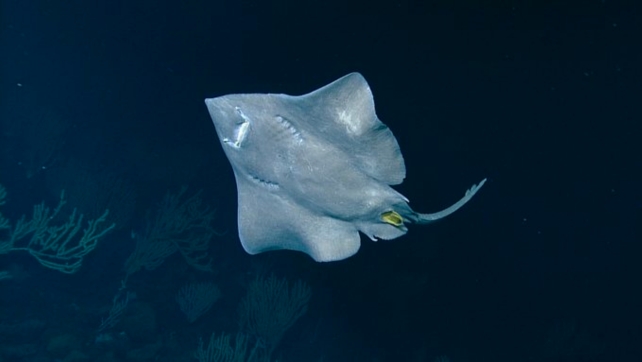A submerged volcano is exuding hot fluid deep below the sea off the Pacific coast of Canada, and thousands of eggs look like ravioli on its summit.
The crew of the 2023 Northeast Pacific Deep-sea Expedition provided a captivating wrap-up video of their once-in-a-lifetime scientific expedition to the underwater volcano that was believed to be extinct.
The video has reportedly the first-ever live footage of a Pacific white skate (Bathyraja spinosissima) laying an egg. Plus, there’s a rare and fascinating octopus nursery, with an octopus protecting her babies from king crabs.
“Our expedition was unprecedented,” marine biologist Cherisse Du Preez from Fisheries and Oceans Canada and her team said in the video. “The discoveries we made and our personal encounters with deep-sea animals have left us speechless.”
???????????? ????
???????????????? ????
???????????? ????Moms rock, even in the deep pic.twitter.com/FLIS2HTk8C
— Dr Cherisse Du Preez ???????? (@CherisseDuPreez) July 6, 2023
British Columbia (BC)’s deep sea is home to a rare, incredible concentration of three wondrous ecosystems – seamounts, hydrothermal vents, and cold seeps – because of the area’s unusually small, active, and nearshore tectonic plates.
Life in all three of BC’s deep-sea biodiversity hotspots has been investigated by a scientific expedition for the first time at depths of up to 3,200 meters (10,500 feet), resulting in the discovery and documentation of “never-before-seen behaviors“.
A big reason for the expedition was to support conservation decisions for a proposed marine protected area dubbed Tang.ɢ̲wan · ḥačxʷiqak · Tsig̱is. The name is a combination of words from different Indigenous peoples who would oversee the marine protected area in cooperation with the Canadian government:
- Tang.ɢwan (phonetic spelling: Tung – Gwun, where G is a voiced uvular stop) is a Haida word meaning ‘deep ocean’
- ḥačxwiqak (phonetic spelling: huch/khwi/kuk) is a Nuu-chah-nulth and Pacheedaht word meaning ‘deepest part of the ocean’
- Tsig̱is (phonetic spelling: tsee-geese) is a Quatsino word referring to a ‘monster of the deep’
The team anticipated cold waters near the seamount, which rises 1,100 meters (3,600 feet) above the seabed, but to their surprise, it was spewing out warm water and covered in corals.
The heat and minerals in the fluid means marine producers can thrive, establishing a local food web that can support a diversity of organisms in the ocean’s otherwise cold, lightless depths.
Even more surprising to the scientists was discovering a Pacific white skate nesting on the summit, 1.5 kilometers (nearly one mile) below the surface.
“We were stunned to also discover the evidence of hydrothermal venting on the seamount providing warmer water to the depths,” the team said, “likely aiding in the successful gestation of the skate eggs.”
One of the deepest-living species of skate, B. spinosissima, is found at depths between 800 and 2,906 meters (2,600 and 9,500 feet). Females can reach a length of 2 meters, and their large rectangular eggs kind of look like they could be ravioli.
The seamount skate nursery was covered in large 0.5-meter eggs, Du Preez told Live Science‘s Sascha Pare, possibly a million of them.
B. spinosissima‘s developing egg cases were seen by scientists in 2018 near hydrothermal vents at the Galápagos Marine Reserve, suggesting that B. spinosissima mothers took advantage of the warm temperatures to naturally incubate their pasta-shaped eggs, perhaps speeding up their babies’ arrival.
You can’t really blame the skates for wanting to meet their kids sooner – some deep-sea skate species have incubation periods of up to 3.5 years.
The egg-covered seamount isn’t currently protected and may be at risk from fishing activities, so researchers will keep an eye on it.
The ocean is an incredible place, and as usual, underwater ecosystems and the extraordinary critters they house continue to enthrall us.
